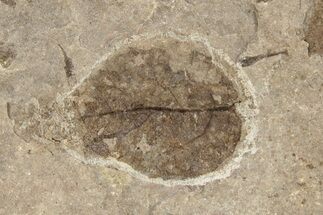This Specimen has been sold.
2.6" Fossil Leaf (Magnolia?) Nodule - Hell Creek Formation
This is an excellently preserved 2.6" fossil leaf nodule (Magnolia sp.?) from the Late Cretaceous Hell Creek Formation on our partner's private quarry in Bowman, North Dakota. It is preserved inside a sandstone concretion.
The Magnolia genus of trees contains some of the oldest existing flowering plants in the world. They first appeared in the fossil record around 100 million years ago, evolving even before bees and other common pollinators we see today. Modern magnolias are evergreen, bearing large, cup-shaped and sweet-smelling flowers pollinated by beetles. Their flowers and pollination routines are thought as largely unchanged in the genus's entire history.
The Magnolia genus of trees contains some of the oldest existing flowering plants in the world. They first appeared in the fossil record around 100 million years ago, evolving even before bees and other common pollinators we see today. Modern magnolias are evergreen, bearing large, cup-shaped and sweet-smelling flowers pollinated by beetles. Their flowers and pollination routines are thought as largely unchanged in the genus's entire history.
Because of its age and sedimentary composition, the Hell Creek Formation has become one of the most paleontologically studied areas in the world. 158 genera of animals and 64 genera of plants are known from the formation and new discoveries are made frequently. In addition to Tyrannosaurs, Ceratopsids, and Hadrosaurs, the formation has yielded remains of amphibians, reptiles, lizards, snakes and turtles, fish and sharks, avian and non-avian dinosaurs, and mammals. The Hell Creek Formation gives the most complete understanding of the environment just before the Cretaceous-Paleogene extinction.
SPECIES
Magnolia sp.?
LOCATION
Bowman, North Dakota
FORMATION
Hell Creek Formation
SIZE
2.6" wide
CATEGORY
SUB CATEGORY
ITEM
#253017
We guarantee the authenticity of all of our specimens.
 Reviews
Reviews











